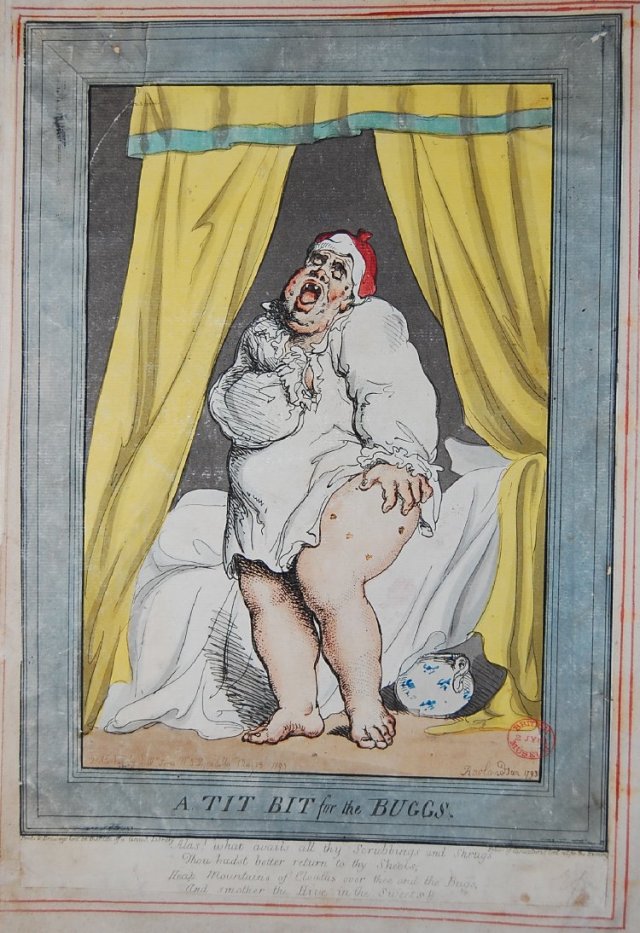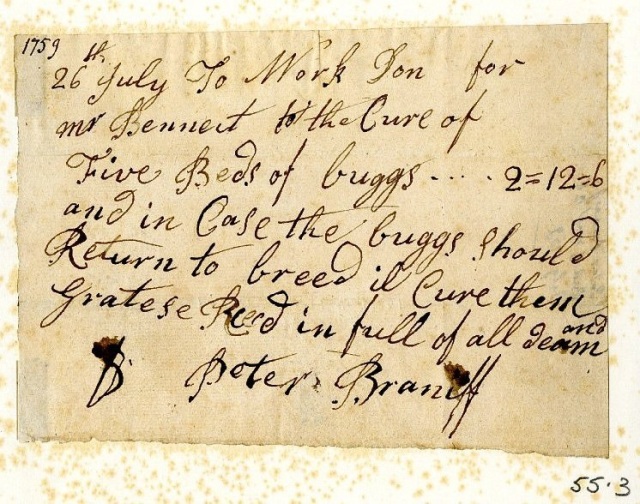Admit it – many of you are scratching already, aren’t you? I was whilst writing this, if I’m honest. One of my readers asked about turpentine being used to kill head lice and this set me off to find out more about the subject and somehow ending up looking at how they dealt with bed bugs (buggs as they were known, somewhere we lost that second ‘g’) in the eighteenth century.

They were clearly a major problem, with many cures being offered to eliminate these little critters such as this from ‘The family jewel, and compleat housewife’s companion or, the whole art of cookery made plain and easy’ by Penelope Bradshaw in 1754.
If your room is very bad, take a pound of rolled brimstone, if there’s only a few, then lay it on the charcoal and get out of the room as fast as you can, or it will take away your breath. Shut the door close, with the blanket over it; and be sure to set it so as nothing can catch fire; if you have any India Pepper throw it in with the Brimstone. Do not open the door under six hours, and then let the door stand open an hour before you go in to open the windows, then brush and sweep your room very clean, wash it well with boiling water. Get a pint of spirits of wine, a pint of spirit of turpentine and an ounce of camphire, shake all well together, and with a bunch of feathers wash your bedstead very well, sprinkle the rest o over your feather-bed and about the wainscot and room.
If you find great swarms about the room, and some not dead, do this over again, and you will be quite clear. Every Spring and Autumn wash your bedstead with half a pint, and you will never have a bug; but if you find any come in with new goods, boxes etc only wash your bedstead and sprinkle it all over your bedding and bed, and you will be clear, but be sure to do it as soon as you find one. If your room is really bad it will be well to paint it.

Here we have an advert from the Daily Post of Thursday, May 18, 1738 from a gentleman offering to eliminate the critters:
Whereas I have for several years, with success, made it my business to destroy those numerous vermin call’d BUGGS, at a reasonable price, being done without the least damage to either bed, bedding or furniture, be the same ever so good; and what is used is without any offensive smell. I likewise undertake hospitals, or other large buildings, and after I have destroyed them, if any should happen the following year to be brought in by people’s cloaths, from other houses, which may happen to new furniture rather than to those I have cured and cleaned, owing to the Power of Nature of what is used, then and in such case I promise to cure them gratis. Those noble persons waited upon my directing to me, JOHN WILLIAMS, at the following coffee-houses, viz. Janeway’s in Cornhill, Richard’s near Temple-Bar.

And this one from Peter Braniff in the Public Advertiser, Saturday, May 17, 1760.
BUGGS, be the ever so intolerable, are effectively destroyed, no cure, no money by Peter Braniff at Number 4, the upper end of Union-court, Holborn, opposite St Andrew’s church; and as his name is so well-known to thousands of people of the best rank, who have employed him to their satisfaction, he refers them for a character before he is employed, which can be had in any division or neighbourhood all over London. Further satisfaction, to enquire at the British Lying-in Hospital, or the City of London Hospital.

So, how much did it cost to get rid of beds buggs – well, that of course varied upon the size of the room and quite frankly, Peter Braniffs’ charges were confusing to say the least, but given that he had a wife and six children support he would have wanted to make as much money as possible. (Peter died in 1769, of consumption, possibly an occupational hazard).
From 5 shillings to seven shillings and six pence, to ten shillings and six pence, to five shillings and some a guinea. Those who please to favour him with their commands, shall be waived on, and shall have twelve months’ time for trial, provided the sum be large. N.B. What he makes use of has no smell neither does it hurt the furniture, and if no alteration is made after he has done, the Buggs will never return, nor breed any more in them during life.
Of course, institutions such as hospitals and the workhouse were expected to maintain high standards of cleanliness, as we see here in this extract from ‘An Account of several work-houses for employing and maintaining the poor’ 1732:
Nurses take care to search all the beds for fleas, buggs and other vermin, once a week, of oftener if occasion; and to have all their beds made, and to sweep and clear their respective wards, every Monday between the hours of eight and ten; that every ward be washed once a week or oftener, as need shall require, and the windows be kept open in all, except the sick-wards, every day during dinner, to air the rooms, except in very rainy weather.
Sleep well tonight everyone and don’t let the bed buggs bite!

Bug breeders in the dog days by Thomas Rowlandson. Beinecke Digital Collections


Head lice die nicely, and so do the eggs, if you force a piece of muslin onto a close-toothed metal comb and soak it in paraffin [kerosene] which works when all the local school lice have become immune to the hair remedies sold. I suspect that a sulfur candle ought to kill bed bugs. WEAR GOGGLES AND A MASK if duplicating this useful pest killer, and seal the room you are fumigating, entering only to throw open the windows for 2 hours before using it, and masked to do so. You can buy them nowadays for dealing with greenhouse pests, but as they are easy to make and as sulfur has already been mentioned, I wouldn’t mind betting they have been around for donkey’s years. Oh and put the candle inside a bowl of water; they are highly flammable. I know that burning sulphur was used to fumigate wine and ale casks in the 1700s.
LikeLiked by 1 person
As a collector of postcards I have quite a few comic cards from before WWI about the problem of Bed Bugs. More recently it has been reported that the increased incidence of bed bugs is a result of people travelling to foreign countries and bringing them back with them. So it is now a problem of affluence and not poverty as was often the case.
LikeLiked by 1 person
I encountered them in a student hostel in Athens many moons ago and it’s not an experience I care to repeat 😉 Thanks as always for such an informative post. (And yes, I’m now itching!)
LikeLiked by 1 person
We picked them up from a hotel on a cross-country trip. The next year was miserable. I was highly allergic to their bites and had no idea what was happening to me. I spent three months stumping various doctors, including specialists, until I stumbled on some pictures of bedbug bites online. They bite in a straight line, frequently leaving three welts (known as breakfast, lunch, and dinner). The bugs had been breeding and feeding off of me for three months by then, so I found tons of evidence of them once I realized what was going on. I battled those buggers for nine months before I was successful in getting rid of them. They are masters in survival and even hide behind outlet covers.
LikeLike
Oh poor you, how awful – like the ‘breakfast, lunch and dinner’ bit. For something so tiny they do a lot of damage! 🙂
LikeLike
My late father-in-law encountered them while serving abroad in the army. He swore by a wet piece of soap but cautioned that it was important to act swiftly once the light was turned on as they scatter instantly! I’m really hoping I never have to put his theories to the test. And yes, I’m scratching now. Thanks! 🙂
LikeLike
There seem to be all kinds of treatments for them, presumably carbolic soap! As for the scratching – As you know Linda, we aim to please our readers hehe 🙂
LikeLiked by 1 person
I think the aim was simply to stick the bug(g)s to the soap as a means of catching them. And thanks. 😉
LikeLiked by 1 person
Pingback: Loyalist Trails 2021-19 – UELAC
Pingback: Loyalist Trails 2023-32 – UELAC